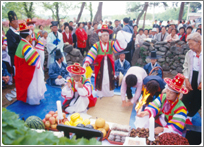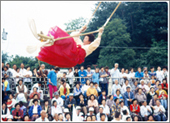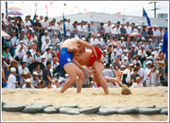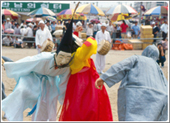The Gangneung Danoje Festival is a traditional Korean festival which    UNESCO designated as a masterpiece of human tradition and intangible cultural heritage on November 25, 2005. A Confucian sacrificial rite is performed at the Daegwallyeong Ridge Tutelary Deity Temple as the central event of the Gangneung Danoje Festival, the representative Korean festival held on Dano, the 5th day of the 5th month on the lunar calendar. The festival is held all over Gangneung City and Daegwallyeong Ridge; it stretches from the Danoje Festival grounds by Namdaecheon Stream which runs through the city of Gangneung - from the 20th day of the 3rd month on the lunar calendar when sacred liquor is brewed for the rite, to the 6th day of the 5th month on the lunar calendar when the rite finishes. UNESCO designated as a masterpiece of human tradition and intangible cultural heritage on November 25, 2005. A Confucian sacrificial rite is performed at the Daegwallyeong Ridge Tutelary Deity Temple as the central event of the Gangneung Danoje Festival, the representative Korean festival held on Dano, the 5th day of the 5th month on the lunar calendar. The festival is held all over Gangneung City and Daegwallyeong Ridge; it stretches from the Danoje Festival grounds by Namdaecheon Stream which runs through the city of Gangneung - from the 20th day of the 3rd month on the lunar calendar when sacred liquor is brewed for the rite, to the 6th day of the 5th month on the lunar calendar when the rite finishes. Traditional games and performances such as a mask drama, a Dano shamanic ritual, swinging, and Yutnori (a Korean traditional game) can be enjoyed. Learning Dano folk songs or carving masks can also be directly experienced. Even though Dano is a traditional holiday celebrated by both Koreans and Chinese, only the Gangneung Danoje Festival is designated as an Intangible Cultural Property in UNESCO's Memory of the World because Korea’s native culture and tradition vividly coexist in the festival. Among Korea’s cultural heritages, the royal ancestral sacrificial rite in 2001, Pansori (a traditional Korean narrative song) in 2003, and the Gangneung Danoje Festival in 2005, have been continuously registered as Intangible Cultural Properties in UNESCO's Memory of the World. | |||
 DANO DANO  In Korea, there are two methods to determine the date, by using the solar calendar or the lunar calendar; thus, the dates on the solar calendar are different from the dates on the lunar calendar. Most of the traditional Korean holidays are dated on the lunar calendar, and an odd numbered day in the same odd numbered month has been thought to be a lucky day. Therefore, the 1st of January, the 3rd of March, the 5th of May, the 7th of July, the 9th of September, etc. on the lunar calendar have been chosen to be traditional holidays. Particularly, the 5th day of May on the lunar calendar is believed to be the most auspicious day because the celestial body of the universe converges on this date so that all the energies of nature are one. It is also believed that it is easy for young people to fall in love passionately on the day of Dano, the 5th day of May on the lunar calendar. As a result, young women have enjoyed swinging beautifully in traditional Korean dresses to attract young men’s attention. Likewise, men have participated in Ssireum (traditional Korean wrestling) to show their robustness and prowess. In addition, the 5th month on the lunar calendar, the month of Dano, is around the time of the rainy season in Korea when bad diseases were easily spread in the olden days. Therefore, traditional customs to prevent various misfortunes have been passed down. Following superstitious customs of Dano for preventing evil spirits and misfortunes, women wash their hair in water infused with irises as well as wear red or blue dresses. For men, they put the roots of irises into the waist of their trousers. | |||
 Dano’s Traditional Customs Dano’s Traditional Customs In the olden times, children took baths and adults splashed water on their backs to avoid the summer heat on the day of Dano. Noblemen were satisfied only when they put their feet into a water jar to maintain their dignity. Dano was a day to promote health and well-being right before summertime; as a result, on this day, there is a traditional custom of giving a folding fan to close acquaintances as a present, which means hoping for a healthy, cool summer. Furthermore, ancestors’ main entertainments on the day of Dano were swinging which was designated for women and wrestling which was designated for men. They also enjoyed a mask dance, a dance with a lion’s mask, and a mask drama. Because Dano is a representative traditional holiday just like Korean New Year’s Day, ancestors used to wear hanboks and pray for a good harvest on the day of Dano.
| |||
 Dano’s Traditional Food Dano’s Traditional Food Dano’s traditional food is quite appetizing as well as nutritious and will ensure a good state of health during summertime. The rice cake made with wormwood or Surichwi (a kind of marsh plant) whose medicinal effect is the best in the summer, is a main dish served on Dano. There is a traditional custom where various kinds of rice cakes such as Ssuktteok (rice cake with wormwood), Manggaetteok (rice cake with supplejack), Yakchotteok (rice cake with medicinal herb), Surichwitteok (rice cake with marsh plant), and wheat flour pancakes are made to share with neighbors. There is also cherry jelly made from cherries which are steamed and boiled in sugar as well as cherry punch made by mixing water and cherries preserved in sugar or honey. Source : visitkorea.or.kr |
13 September 2011
The Gangneung Danoje Festival
Subscribe to:
Post Comments (Atom)





No comments:
Post a Comment